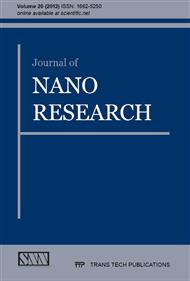[1]
Lutolf MP, Hubbell JA. Synthetic biomaterials as instructive extracellular microenvironments for morphogenesis in tissue engineering. Nature Biotech. 23 (2005): 47-55.
DOI: 10.1038/nbt1055
Google Scholar
[2]
Khetani SR, Bhatia SN. Engineering tissues for in vitro applications. Curr. Opin. Biotech. 17 (2006): 524-531.
Google Scholar
[3]
Rosso F, Giordano A, Barbarisi M, Barbarisi A. From Cell-ECM Interactions to Tissue Engineering. J. Cell. Physiol. 199 (2004): 174-180.
DOI: 10.1002/jcp.10471
Google Scholar
[4]
Peppas NA, Langer R. New challenges in biomaterials. Science 263 (1994): 1715-1720.
DOI: 10.1126/science.8134835
Google Scholar
[5]
Langer R, Tirell DA. Designing materials for biology and medicine. Nature 428 (2004): 487-492.
Google Scholar
[6]
Folch A, Toner M. Microengineering of Cellular Interactions. Annu. Rev. Biomed. Eng. 2: (2000) 227-256.
DOI: 10.1146/annurev.bioeng.2.1.227
Google Scholar
[7]
Tzanakakis ES, Hansen LK, Hu WS. The role of actin filaments and microtubules in hepatocyte spheroid self-assembly. Cell. Motil. Cytoskeleton 48 (2001): 175-189.
DOI: 10.1002/1097-0169(200103)48:3<175::aid-cm1007>3.0.co;2-2
Google Scholar
[8]
Berrier ALY, Kenneth M. Cell-Matrix Adhesion. J. Cell Physiol. 213 (2007): 565-573.
Google Scholar
[9]
Pereira Rodrigues N, Poleni PE, Guimard D, Sakai Y, Arakawa T, Fujii T. Modulation of Hepatocarcinoma Cell Morphology and Activity by Parylene-C coating on PDMS. PloS ONE 5 (2010): e9667.
DOI: 10.1371/journal.pone.0009667
Google Scholar
[10]
Lee JH, Lee HB. A wettability gradient as a tool to study protein adsorption and cell adhesion on polymer surfaces. J. Biomater. Sci. (Polymer Ed. ) 4 (1993): 467-481.
DOI: 10.1163/156856293x00717
Google Scholar
[11]
Harnett EM, Alderman J, Wood T. The surface energy of various biomaterials coated with adhesion molecules used in cell culture. Colloids Surf. B 55 (2007): 90-97.
DOI: 10.1016/j.colsurfb.2006.11.021
Google Scholar
[12]
Pamula E, De Cupere V, Dufrêne YF, Rouxhet PG. Nanoscale organization of adsorbed collagen: Influence of substrate hydrophobicity and adsorption time. J. Colloid and Interface Sci. 271 (2004): 80-91.
DOI: 10.1016/j.jcis.2003.11.012
Google Scholar
[13]
Denis FA, Hanarp P, Sutherland DS, Gold J, Mustin C, Rouxhet PG, Dufrene YF. Protein adsorption on model surfaces with controlled nanotopography and chemistry. Langmuir 18 (2002): 819-828.
DOI: 10.1021/la011011o
Google Scholar
[14]
Dupont-Gillain CC, Pamula E, Denis FA, De Cupere VM, Dufrêne YF, Rouxhet PG. Controlling the supramolecular organisation of adsorbed collagen layers. J Mater Sci Mater M 15 (2004): 347-353.
DOI: 10.1023/b:jmsm.0000021100.71256.29
Google Scholar
[15]
McDaniel DP, Shaw GA, Elliott JT, Bhadriraju K, Meuse C, Chung K-H. The Stiffness of Collagen Fibrils Influences Vascular Smooth Muscle Cell Phenotype. Biophys J 92 (2007): 1759-1769.
DOI: 10.1529/biophysj.106.089003
Google Scholar
[16]
Sherratt MJ, Bax DV, Chaudhry SS, Chaudhry SS, Hodson N, Lu JR, Saravanapavan P, Kielty CM. Substrate chemistry influences the morphology and biological function of adsorbed extracellular matrix assemblies. Biomaterials 26 (2005): 7192-7206.
DOI: 10.1016/j.biomaterials.2005.05.010
Google Scholar
[17]
Pirone DM, Chen CS. Strategies for Engineering the Adhesive Microenvironment. J. Mamm. Gl. Biol. Neoplasia 9 (2004): 405-417.
Google Scholar
[18]
Rhaghavan S, Chen CS. Micropatterned Environments in Cell Biology. Adv. Mater. 16 (2004): 1303-1313.
Google Scholar
[19]
Rosenthal A, Macdonald A, Voldman J. Cell patterning chip for controlling the stem cell microenvironment. Biomaterials 28: (2007) 3208-3216.
DOI: 10.1016/j.biomaterials.2007.03.023
Google Scholar
[20]
Khetani SR, Bhatia SN. Microscale culture of human liver cells for drug development. Nature Biotechnol. 26 (2008): 120-126.
DOI: 10.1038/nbt1361
Google Scholar
[21]
Whitesides GM, Ostuni ES, Takayama S, Jiang X, Ingber DE. Soft Lithography in Biology and Biochemistry. Annu. Rev. Biomed. Eng. 3 (2001): 335-373.
DOI: 10.1146/annurev.bioeng.3.1.335
Google Scholar
[22]
Loeb GE, Walker AE, Uematsu S, Konigsmark BW. Histological reaction to various conductive and dielectric films chronically implanted in the subdural space. J. Biomed. Mater. Res. 11 (1977): 195-210.
DOI: 10.1002/jbm.820110206
Google Scholar
[23]
Schwarz JA, Contescu CI, Putyera K. Dekker encyclopedia of nanoscience and nanotechnology. CRC Press (2004).
Google Scholar
[24]
Chang TY, Yadav VG, Leo SD, Mohedas A, Rajalingam B. Cell and protein compatibility of parylene-C surfaces. Langmuir 23 (2007): 11718-11725.
DOI: 10.1021/la7017049
Google Scholar
[25]
Dufrêne YF, Marchal TG, Rouxhet PG. Influence of substratum surface properties on the organization of adsorbed collagen films: in situ characterization by atomic force microscopy. Langmuir 15 (1999): 2871-2878.
DOI: 10.1021/la981066z
Google Scholar
[26]
Elliott JT, Woodward JT, Umarji A, Mei Y, Tona A. The effect of surface chemistry on the formation of thin films of native fibrillar collagen. Biomaterials 28 (2007): 576-585.
DOI: 10.1016/j.biomaterials.2006.09.023
Google Scholar
[27]
Lazarevich NL, Cheremnova OA, Varga EV, Ovcinnikov DA, Kudrjavtseva EI, Morozova OV, Fleishman DI, Engelhandt NV, Duncan SA. Progression of HCC in mice is associated with a downregulation in the expression of hepatocyte nuclear factors. Hepatology 39 (2004).
DOI: 10.1002/hep.20155
Google Scholar
[28]
Powers MJ, Griffith-Cima L. Motility behavior of hepatocytes on extracellular matrix substrata during aggregation. Biotech. Bioeng. 50 (1996): 392-403.
DOI: 10.1002/(sici)1097-0290(19960520)50:4<392::aid-bit6>3.0.co;2-g
Google Scholar
[29]
Amstrong PB. Cell Sorting Out: The Self-Assembly of Tissues In Vitro. Crit. Rev. Biochem. Mol. Biol. 24 (1989): 119-149.
Google Scholar
[30]
Powers MJ, Rodriguez RE, Griffith LG. Cell-substratum adhesion strength as a determinant of hepatocyte aggregate morphology. Biotech. Bioeng. 53 (1997): 415-426.
DOI: 10.1002/(sici)1097-0290(19970220)53:4<415::aid-bit10>3.0.co;2-f
Google Scholar
[31]
Song G, Ohashi T, Sakamoto N, Sato M. Adhesive force of Human Hepatoma (HepG2) cells to Endothelial Cells and Expression of E-Selectin. Mol. Cell. Biol. 3 (2006): 61-68.
Google Scholar
[32]
Mayoral R, Fernandez-Martinez A, Bosca L, Martin-Sanz P. Prostaglandin E2 promotes migration and adhesion in hepatocellular carcinoma cells. Carcinogenesis 26 (2005): 753-761.
DOI: 10.1093/carcin/bgi022
Google Scholar
[33]
Konopka G, Tekiela J, Iverson M, Wells C, Duncan SA. Junctional Adhesion Molecule-A Is Critical for the Formation of Pseudocanaliculi and Modulates E-cadherin Expression in Hepatic Cells. J. Biol. Chem. 282 (2007): 28137-28148.
DOI: 10.1074/jbc.m703592200
Google Scholar
[34]
Ho C-T, Lin R-Z, Wen W-Y, Chang H-Y, Liu C-H. Rapid heterogenous liver-cell on chip patterning via the enfanced field-induced dielectrophoresis trap. Lab-on-a-Chip 6 (2006): 724-734.
DOI: 10.1039/b602036d
Google Scholar


